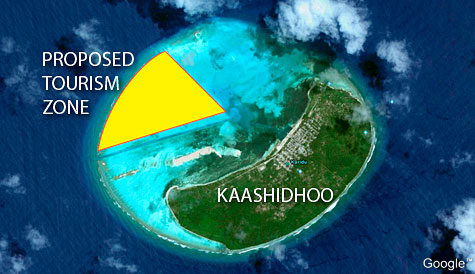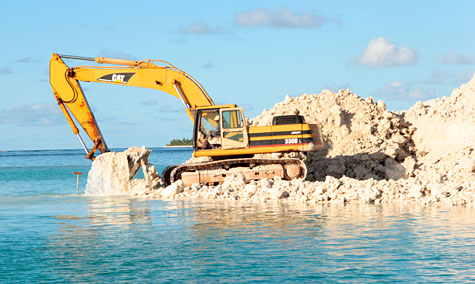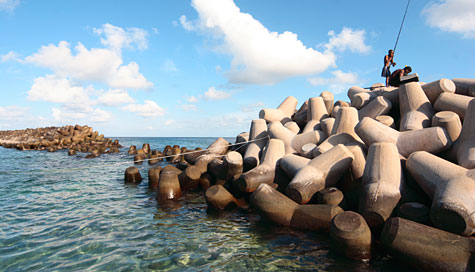TOWARDS AN ARTIFICIAL PARADISE ON EARTH
The Government has recently announced plans to develop ten artificial islands by reclaiming natural lagoons of inhabited islands of the Maldives to increase development opportunities under the National Population Consolidation Strategy and Programme.

Aerial view of Kaashidhoo island showing the proposed area for the artificial island.
These artificial islands, which will be developed as tourist resorts, are a growing concern for environmentalists and the public in general due to their potential damaging impact on coastal ecosystems as the country’s beach systems are highly dynamic.
The initial preparation to develop an artificial island for a resort in the natural lagoon of Kaafu Kaashidhoo is already in progress. Haa Dhaal Nolhivramfaru, Haa Alifu Kelaa, Alifu Alifu Thoddoo, Faafu Nilandhoo, Faafu Magoodhoo and Laamu Gaadhoo and Kaashidhoo are seven islands selected as locations to develop the artificial islands in their natural lagoons presently surrounded with quite healthy coral reef flats.

Laamu Gaadhoo beach is one of the most important nesting areas for marine turtles in the Maldives with over 100 turtles, an endangered species, nesting there annually. Laamu Gaadhoo’s beach is a protected area for marine turtles and egg harvesting has been banned in order to protect the dwindling turtle population. All five species of marine turtles seen in the Maldivian waters are on Appendix I (the most endangered species) of the Convention on International Trade in Endangered Species (CITES). The development of an artificial island in the lagoon of Gaadhoo will endanger marine turtles and will come into direct conflict with the policy of conservation already in place.
Kaafu Atoll Kaashidhoo has a large natural lagoon almost the size of the island with quite a healthy reef flat. At the beginning of 20th century, there were two islets called Huraa and Fushi, in the lagoon of Kaashidhoo. However, those two small islets have eroded now (Changes in the Topography of the Maldives, 1990, page 32, Hassan Ahmed Maniku). This shows how dynamic Kaashidhoo’s beach is to erosion and accretion.

In early 20th Century Gulhi Falhu was an uninhabited island at times used to quarantine lepers.
Erosion of some islands and formation of new ones are, in fact, ongoing processes in the Maldives Archipelago. Many islands have been abandoned in the past due to beach erosion and the natives of these islands had been moved to better and bigger islands. It had been first documented by Persian geographer Abu Zayd of Siraf in 890 A.D and Arab geographer Al Biruni in 1030 A.D. In early 20th century Gulhi Falhu, to the west of Villingili in Male’ Atoll, was an uninhabited island at times used to quarantine lepers. By mid-20th century the island was completely eroded and turned into a lagoon (Dhivehi Thaareekhah Au Alikameh, 1958, page 34, Dhivehi Bahaai Thaareekhah Khidhmaiy Kuraa Gaumee Marukaz). In one of the ironies of modern times, Gulhi Falhu is to be reclaimed for making a commercial zone. Coastal modifications and reclamation of lagoons in such dynamic ecosystems often pose a threat to the survival of these fragile atoll islands.

Harbour dredging one of the common human-induced threat to reef ecosystem in the Maldives.
Coastal development is usually ecologically-destructive and leads to major changes to beach profiles of islands normally associated with changes in the flow of current and waves near the shore. Presently coastal development such as land reclamation and increased harbour dredging is the major and most common human-induced physical danger to coastal and coral reef ecosystems in the Maldives. Severe cases of beach erosion have been reported in inhabited islands and several resort islands in recent years. Recent beach erosion could be due to the man-made changes, such as construction of coastal infrastructures, channel blasting with dynamite, dredging and reclamation.
The Maldives is a coral nation and coral ecosystem add significantly to the national economy and specifically to the value of beach-based and diving-based tourism, supporting activities such as diving, snorkeling and glass-bottom boat operations. In addition to this, coral also provides to the creation of white sand beaches.

Coral worth thousands of dollars destroyed by dredging a harbour in a virgin reef in front of Royal Island in Baa Atoll. The harbor was made for mooring the vessels used by the resort, even though many harbours exist nearby.
A report published by the United Nations Environment Programme (UNEP), in 2006 argues that protecting coral reefs and mangroves makes economic sense. The report, titled “In the Front Line: Shoreline Protection and other Ecosystem Services from Mangroves and Coral Reefs“, argues that conserving coral reefs and mangroves ecosystems for the services they give — fisheries protection, mitigation of beach erosion and as a source for medicinal substances — is cost-effective than destroying them and replacing their function with artificial structures.
The UNEP report concludes that:
- The estimated value of coral reefs is between $100,000 to 600,000 per square kilometer a year.
- The cost of protecting them, through the management costs of a marine protected area, is just $775 per square kilometer per annum.
- The costs of erecting artificial breakwaters made of concrete tetrapods around the Male, Maldives, following the degradation of the natural reef, was $10 million per kilometer.
- In Indonesia, a hotel in West Lombok has spent an average of $125,000 per year over seven years restoring its 250 metre-long beach following erosion as a result of offshore coral mining.
- A typical coral reef can absorb up to 90 percent of the energy of wind-generated waves thus protecting coastal areas from damage. The report cites a study from Sri Lanka which shows that one square kilometer of coral reef stops 2,000 cubic meters of coastal erosion per year.

In the Maldives, a reef flat adjacent to the capital of Malé was filled using coral rubble and causing sedimentation of nearby reefs. Their degradation was partly responsible for reduced shore protection and extensive flooding in 1987, which resulted in 20-30 percent of the new infill being lost. Subsequently, artificial breakwaters of concrete tetrapods were installed at a cost of US$10,000 per metre (US$10 million per kilometer) (Brown, 1997). Not only was this expensive, but it did not prevent serious flooding during the tsunami. (In the Front Line, UNEP-WCMC/UNEP 2006).
In the light of the UNEP report, it is important to assign monetary values to ecosystems such as coral reefs in the Maldives. In order to better understand and recognize the value of nature’s services, it is also important to estimate economic cost of ecological damage that is going to be incurred from developing artificial islands in the lagoons of 10 inhabited islands, especially deposition of sediment on the adjacent reef flats of natural islands, following intense dredging and reclamation.
Beach erosion on the adjacent natural island could occur by developing artificial islands because of alteration of natural circulation of the water and wave. The cost of erecting artificial structures to replace the function of lost beach areas must also be taken in consideration. Loss of reef, ornamental and bait fishery must be also estimated in economic value, so that people can better value and conserve these natural assets.

Untouched Islands of Maldives: Ibn Battuta, the celebrated 14th-century Muslim geographer called the Islands of the Maldives “one of the wonders of the world,” and commented on their annular form and proximity to each other: “A hundred or so are arranged in a circle like a ring, with an opening at one point to form a passage; ships may reach the islands only through this passage…. They are so close together that when leaving one, the tops of the palm trees on the next are visible.”
The proposed plan to develop artificial islands by reclaiming lagoons will have negative impacts on the aesthetic beauty of Maldives, a country renowned for green islands, white beaches and spectacular reefs and lagoons. The plan will harm several species leading to the loss of biodiversity as reefs are affected by sedimentation. It has the potential to cause beach erosion leading to economic losses, and will increase the vulnerability of the islands and their population to disasters such as high swells, storm surges and tsunamis. Since coral reefs and mangroves are the first lines of defense against such disasters, the destruction of coral reefs through such a plan is in contradiction to the claims that the Maldives is at the forefront of the global fight against climate change.
